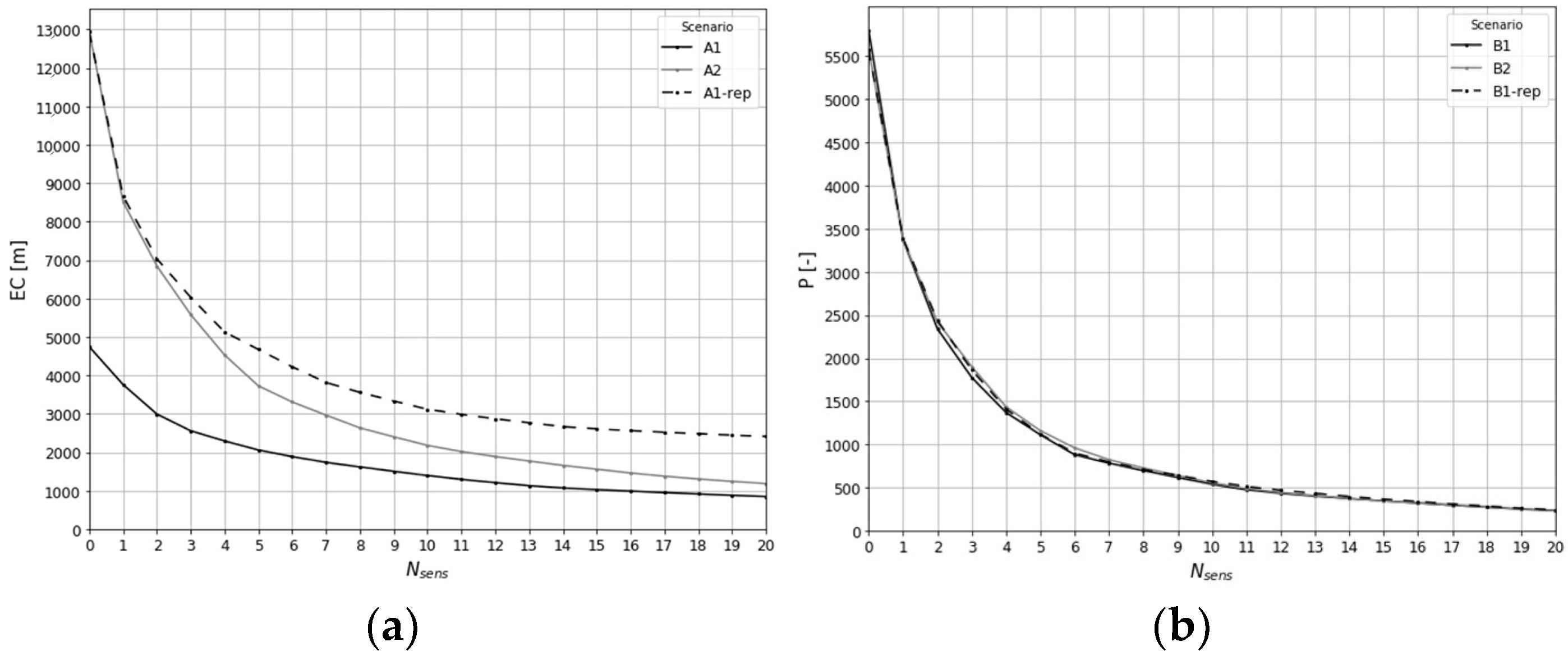Exploring the Impact of Pulsed Demand Model on the Quality Sensor Placement in Water Distribution Networks †
Abstract
1. Introduction
2. Materials and Methods
2.1. Demand Modelling
2.2. Water Quality Sensor Placement
- the first kind was aimed at minimizing simultaneously the number f1 = Nsens [-] of installed sensors and the extent f2 = EC = mean(Lc,s) [m] of contamination, where Lc,s [m] is the total length of the contaminated pipeline during a contamination scenario s at the time of the first detection;
- the second kind was aimed at minimizing simultaneously f1 and the population f3 = P = mean(ps) [-] exposed to ingestion, where ps [-] is the number of people that ingested contaminated water in the contamination scenario s at the time of the first detection, considering the five-fixed-times ingestion model [6].
3. Results
- -
- Scenario A1: EC as second objective function, TDA for the nodal demand;
- -
- Scenario A2: EC as second objective function, BUA for the nodal demand;
- -
- Scenario B1: P as second objective function, TDA for the nodal demand;
- -
- Scenario B2: P as second objective function, BUA for the nodal demand;
4. Discussion
Author Contributions
Funding
Institutional Review Board Statement
Informed Consent Statement
Data Availability Statement
Acknowledgments
Conflicts of Interest
References
- Giudicianni, C.; Herrera, M.; Di Nardo, A.; Creaco, E.; Greco, R. Multi-criteria method for the realistic placement of water quality sensors on pipes of water distribution systems. Environ. Model. Softw. 2022, 152, 105405. [Google Scholar] [CrossRef]
- Adedoja, O.S.; Hamam, Y.; Khalaf, B.; Sadiku, R. A state-of-the-art review of an optimal sensor placement for contaminant warning system in a water distribution network. Urban Water J. 2018, 15, 985–1000. [Google Scholar] [CrossRef]
- Blokker, E.J.M.; Vreeburg, J.H.G.; Buchberger, S.G.; Van Dijk, J.C. Importance of demand modelling in network water quality models: A review. Drink. Water Eng. Sci. 2008, 1, 27–38. [Google Scholar] [CrossRef]
- Creaco, E.; Blokker, E.J.M.; Buchberger, S.G. Models for generating household water demand pulses: Literature review and comparison. J. Water Resour. Plan. Manag. 2017, 143, 04017013. [Google Scholar] [CrossRef]
- Creaco, E.; Farmani, R.; Kapelan, Z.; Vamvakeridou-Lyroudia, L.; Savic, D. Considering the mutual dependence of pulse duration and intensity in models for generating residential water demand. J. Water Resour. Plan. Manag. 2015, 141, 04015031. [Google Scholar] [CrossRef]
- Davis, M.J.; Janke, R. Development of a probabilistic timing model for the ingestion of tap water. J. Water Resour. Plan. Manag. 2009, 135, 397–405. [Google Scholar] [CrossRef]
- Janke, R.; Murray, R.; Haxton, T.M.; Taxon, T.; Bahadur, R.; Samuels, W.; Uber, J. Threat Ensemble Vulnerability Assessment-sensor Placement Optimization Tool (TEVA-SPOT) Graphical User Interface User’s Manual; US EPA National Homeland Security Research Center (NHSRC): Cincinnati, OH, USA, 2012; pp. 1–109.
- Alvisi, S.; Creaco, E.; Franchini, M. Segment identification in water distribution systems. Urban Water J. 2011, 8, 203–217. [Google Scholar] [CrossRef]
- Giudicianni, C.; Campisano, A.; Di Nardo, A.; Creaco, E. Pulsed Demand Modeling for the Optimal Placement of Water Quality Sensors in Water Distribution Networks. Water Resour. Res. 2022, 58, e2022WR033368. [Google Scholar] [CrossRef]


Disclaimer/Publisher’s Note: The statements, opinions and data contained in all publications are solely those of the individual author(s) and contributor(s) and not of MDPI and/or the editor(s). MDPI and/or the editor(s) disclaim responsibility for any injury to people or property resulting from any ideas, methods, instructions or products referred to in the content. |
© 2024 by the authors. Licensee MDPI, Basel, Switzerland. This article is an open access article distributed under the terms and conditions of the Creative Commons Attribution (CC BY) license (https://creativecommons.org/licenses/by/4.0/).
Share and Cite
Giudicianni, C.; Creaco, E. Exploring the Impact of Pulsed Demand Model on the Quality Sensor Placement in Water Distribution Networks. Eng. Proc. 2024, 69, 174. https://doi.org/10.3390/engproc2024069174
Giudicianni C, Creaco E. Exploring the Impact of Pulsed Demand Model on the Quality Sensor Placement in Water Distribution Networks. Engineering Proceedings. 2024; 69(1):174. https://doi.org/10.3390/engproc2024069174
Chicago/Turabian StyleGiudicianni, Carlo, and Enrico Creaco. 2024. "Exploring the Impact of Pulsed Demand Model on the Quality Sensor Placement in Water Distribution Networks" Engineering Proceedings 69, no. 1: 174. https://doi.org/10.3390/engproc2024069174
APA StyleGiudicianni, C., & Creaco, E. (2024). Exploring the Impact of Pulsed Demand Model on the Quality Sensor Placement in Water Distribution Networks. Engineering Proceedings, 69(1), 174. https://doi.org/10.3390/engproc2024069174






